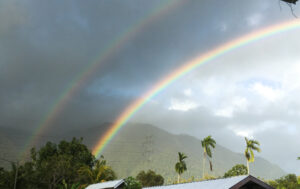Heavy rains require extra preparation when living with CAD
A columnist must consider her health as she prepares for potential floods
Written by |

“It rained and it rained and it rained. Piglet told himself that never in all his life, and he was goodness knows how old—three, was it, or four?—never had he seen so much rain.” — A.A. Milne’s “Winnie-the-Pooh“
This was a perfect description of the rain coming down. Before, everything was peaceful. I needed that as I was on day three of a virulent intestinal malady. But then the heavens opened up.
I really do like rain — that is, some rain. But precipitation in March brings feelings of danger and impending doom. I associate it with tornadoes (when I’m in the U.S.) and floods and landslides (when I’m here in Papua, Indonesia). Tuesday evening, just after supper, the rains began.
Last week’s rain
Half an hour later, the raindrops were now full buckets of cold water, and all my Spidey senses had begun to tingle. It was only five years ago that landslides and flash floods here in Sentani cost at least 89 people their lives. In 2007, similar torrential rains destroyed all five of the main bridges through town, severing supply and food lines from the nearest port.
I took out my mental emergency assessment list and ticked off the preparations I had on hand. I assessed my physical ability to assist in the recovery efforts as well. My needs with cold agglutinin disease (CAD) made that a requirement.
The temperature was in the mid-70s F. That is cold here. The bottom drawer of my dresser holds my sweaters and chemical hand warmers. There was a possibility I’d need them.
CAD is an autoimmune hemolytic anemia triggered by my red blood cells being exposed to temperatures of 65 F or lower. Something as benign as stepping into a puddle of cold water will start the process of hemolysis. That is a possibility if I’m wet and riding my motorcycle. When there is flooding in Sentani, I could step into some cold, flowing water when I glide to a stop.
Sizing up the situation
I reviewed our own housing situation. We live on a ridge on the northern slope of Gunung Baboko. In the past, boulders have washed down the slope and crops, buildings, livestock, and people have been carried away. However, this property is not next to a stream where such landslides have occurred. The likelihood of such a thing happening to our property is low.
The next consideration was the availability of water. We could expect water pipes to be broken. Again, we have planned for that and have a day and a half of water stored. Further, we can purify water so we will have something to drink and use for cooking.
My next concern was how I, in my anemic condition, could help others. CAD is always present. My hemoglobin, although just under a normal reading, shows that my blood doesn’t carry enough oxygen to fully power my internal organs or enable me to be active and serve others for long stretches of time.
In the past, the expatriate community made our school and other buildings available to the displaced community. This meant long hours of meal preparation and cleanup, as well as performing janitorial work to keep personal facilities clean and ready for use. As the rains fell, I prayed for strength to meet the looming challenge. It would put all of my physical resources at full capacity.
The final consideration was exposure to all sorts of germs. I get sick at the drop of a hat. This is normal for “CADdies,” as those with CAD call ourselves. Is it prudent to expose myself to germs, knowing my personal recovery would take months instead of a week or two? The answer: No, it isn’t prudent, but I would do it anyway, trusting God to take care of me whether or not I became ill.
Once the danger passed
The rain slacked off in intensity at about 10:30 p.m., but it didn’t stop. It rained all night. Pokey, my dog, looked at me with resentment as if there were something I could do about it. Our yard had standing water in it about a foot deep for a few hours.
Finally, around dawn, the steady rain turned to drizzle. It ended at about 8 a.m. There was still enough cloud cover that my solar clothes dryer didn’t work. With trepidation, I began reading the local news to see if anyone had been injured.
This rain was not the worst in modern history. Nevertheless, it did bring some sadness. At least one family lost their house, and mud covered many of the roads to and through town. In my final assessment, emergency preparations were not needed. My CAD-restricted body was not challenged.
Note: Cold Agglutinin Disease News is strictly a news and information website about the disease. It does not provide medical advice, diagnosis, or treatment. This content is not intended to be a substitute for professional medical advice, diagnosis, or treatment. Always seek the advice of your physician or other qualified health provider with any questions you may have regarding a medical condition. Never disregard professional medical advice or delay in seeking it because of something you have read on this website. The opinions expressed in this column are not those of Cold Agglutinin Disease News or its parent company, Bionews, and are intended to spark discussion about issues pertaining to cold agglutinin disease.






Leave a comment
Fill in the required fields to post. Your email address will not be published.